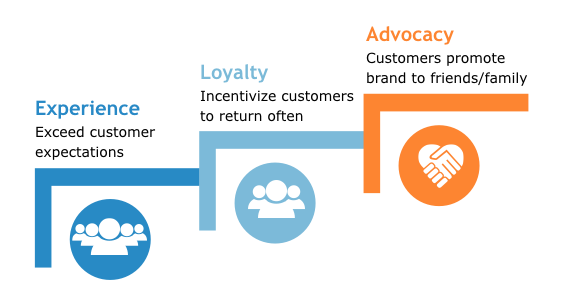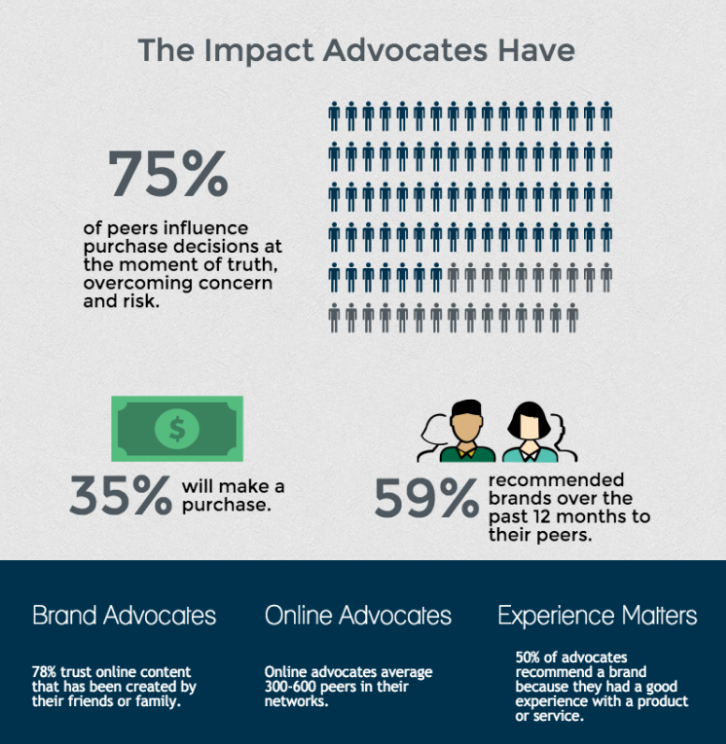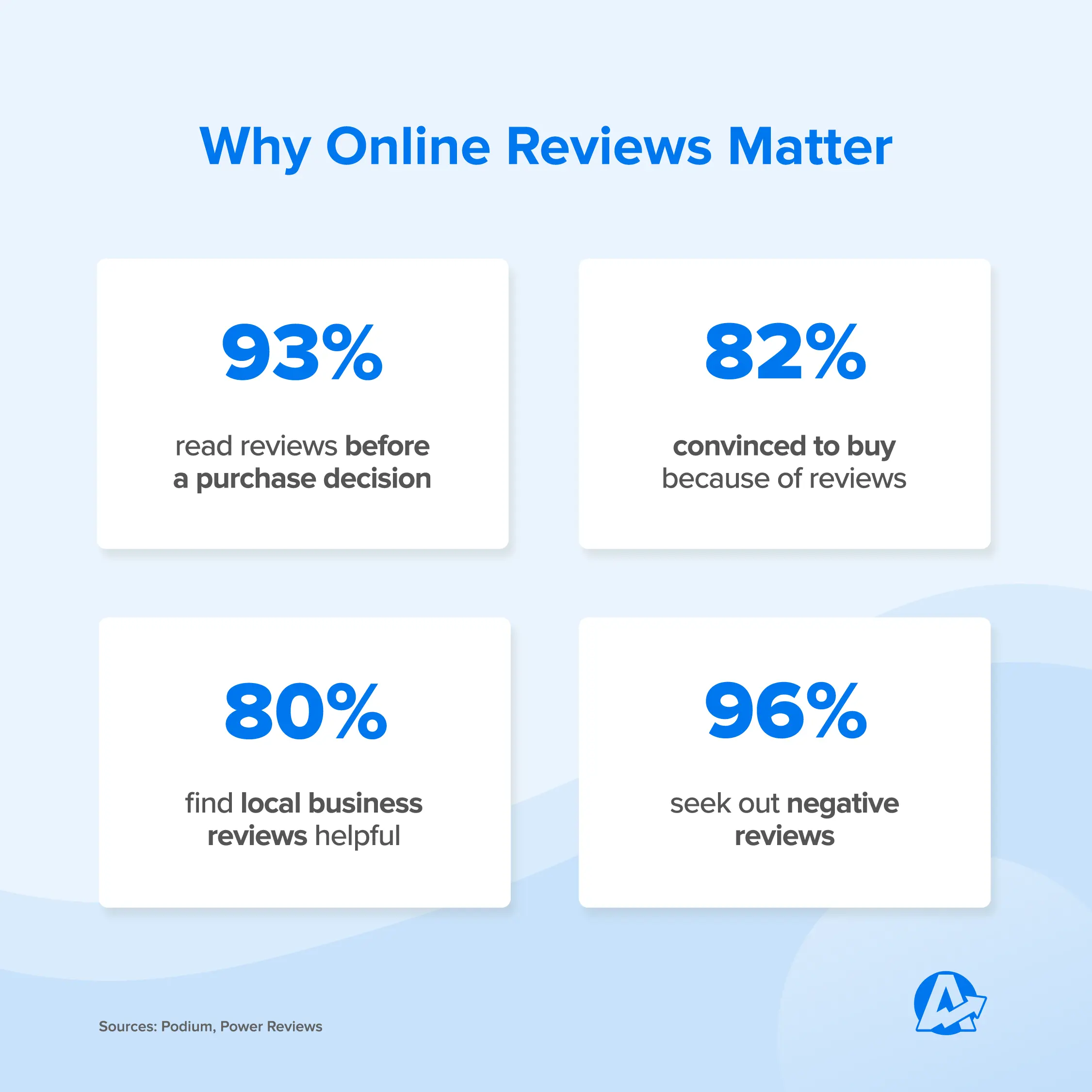.jpg)
Table of Content:
- Understanding Advocacy Marketing.
- Creating Exceptional Customer Experiences.
- Identifying and Nurturing Brand Advocates.
- Leveraging User-Generated Content (UGC).
- Launching Referral Programs.
- Engaging with User Communities.
- Showcasing Customer Testimonials and Reviews.
- Social Media Advocacy.
- Rewarding and Recognizing Advocates.
- Measuring and Optimizing Advocacy Campaigns.
In the dynamic world of e-commerce, the term "advocacy marketing" has risen to prominence as a game-changer for businesses seeking sustainable growth and customer loyalty. If you're an e-commerce entrepreneur or marketer looking to unlock the true potential of advocacy marketing, you've come to the right place.
Advocacy marketing isn't just a buzzword; it's a powerful strategy that can elevate your e-commerce brand to new heights. It's about turning your satisfied customers into enthusiastic brand advocates who not only keep coming back for more but also spread the word about your products or services far and wide.
Imagine having an army of dedicated customers singing your praises, recommending your brand to their friends, and defending your reputation online. That's the magic of advocacy marketing. It's like having a squad of trusty allies in the ever-competitive battlefield of online commerce.
Now, you might be wondering, "How can I harness this power for my own e-commerce business?" We're here to guide you through it. In this blog post, we'll dive deep into the world of advocacy marketing, providing you with not just theories, but proven strategies that have worked wonders for successful e-commerce brands.
We'll explore the art of creating exceptional customer experiences, finding and nurturing your brand advocates, leveraging user-generated content, launching effective referral programs, engaging with user communities, showcasing customer testimonials and reviews, mastering social media advocacy, rewarding and recognizing your advocates, and, perhaps most importantly, measuring and optimizing your advocacy campaigns.
Whether you're a seasoned e-commerce pro or just starting your online business journey, there's something here for everyone. So, let's embark on this advocacy marketing adventure together, as we uncover the ten strategies that can transform your e-commerce brand into a customer-driven powerhouse.
1. Understanding Advocacy Marketing
Advocacy marketing, also known as brand advocacy or customer advocacy, is a marketing strategy that capitalizes on the power of satisfied customers who become enthusiastic promoters of your brand. These brand advocates not only make repeat purchases but actively recommend your products or services to their friends, family, and social circles.
Why Advocacy Marketing Matters:
In a world where consumers are bombarded with advertising and have countless options at their fingertips, advocacy marketing stands out as a trustworthy and influential strategy. Consider these compelling reasons why advocacy marketing is crucial for your e-commerce success:
1. Trust and Credibility: According to the Edelman Trust Barometer, 63% of consumers trust information from "a person like yourself" more than they trust messages from businesses or CEOs. Brand advocates fit this description perfectly. When they speak highly of your brand, it carries weight.
2. Cost-Effective: Advocacy marketing can be highly cost-effective. It leverages existing customer relationships rather than solely relying on expensive advertising campaigns.
3. Increased Sales: According to Ambassador, 71% of consumers are more likely to make a purchase based on social media referrals. When customers advocate for your brand on platforms like Instagram, Facebook, or Twitter, it can drive significant sales.
Let's look at some real-life examples of advocacy marketing in action:
1. Apple's Cult Following: Apple has cultivated a passionate and vocal community of brand advocates. Apple fans eagerly anticipate new product releases and often share their enthusiasm on social media, creating a buzz that generates immense attention and sales.
2. Airbnb's Host Community: Airbnb encourages hosts to become advocates by offering referral bonuses for bringing in new hosts and guests. This strategy has helped Airbnb expand its global network rapidly.
3. GoPro's User-Generated Content: GoPro encourages its customers to capture and share their extreme sports adventures using their cameras. The resulting user-generated content showcases the product's capabilities and inspires others to make a purchase.
4. Amazon's Customer Reviews: Amazon's customer reviews, both positive and negative, contribute to advocacy marketing. Honest reviews from real customers build trust and influence purchasing decisions.
Now that you understand the importance of advocacy marketing and have seen it in action, let's delve into the strategies you can implement to harness this power for your e-commerce business. We'll explore each strategy in detail, providing actionable insights to help you build and sustain a community of brand advocates.

2. Creating Exceptional Customer Experiences
In the world of e-commerce, where countless options are just a click away, creating exceptional customer experiences is not just a nice-to-have—it's a necessity. Exceptional experiences are the bedrock upon which brand loyalty and advocacy are built. When customers feel valued, heard, and delighted, they are not only more likely to return for future purchases but also become enthusiastic advocates for your brand. Here's how you can go about it:
1. Personalization: One size does not fit all in the world of e-commerce. To create exceptional experiences, tailor the shopping journey to individual preferences. Leverage data and technology to offer personalized product recommendations, special offers, and content that aligns with each customer's interests and past interactions with your brand.
2. Responsive Customer Support: The importance of excellent customer support cannot be overstated. Ensure that your customers can reach out for assistance through various channels such as live chat, email, and phone. When issues or questions arise, responding promptly and effectively can turn potential frustrations into positive experiences.
3. Simplify the Buying Process: A cumbersome checkout process or confusing website navigation can quickly erode the customer's experience. Make the purchasing process as seamless as possible, minimizing any friction or obstacles that may deter customers from completing their transactions.
4. Solicit Feedback and Act on It: Listen to your customers. Encourage them to share their feedback and suggestions, and then take meaningful action based on their insights. This not only shows that you value their input but also helps you continually improve your offerings.
5. Anticipate Customer Needs: Go the extra mile to understand what your customers might need before they even ask for it. Offer additional product information, sizing guides, or complementary items that enhance their shopping experience. Proactively addressing potential pain points can impress customers and keep them coming back.
Examples of Brands with Exceptional Customer Experiences
Let's take a look at some brands that have set the bar high when it comes to providing exceptional customer experiences:
1. Zappos: Zappos, an online shoe and clothing retailer, is renowned for its customer-centric approach. They prioritize going above and beyond to ensure customer satisfaction. For instance, they once delivered a pair of shoes overnight to a customer for free, even though the purchase was just a pair of slippers.
2. Warby Parker: Warby Parker, an eyewear brand, stands out with its innovative approach to the eyewear industry. They offer a "Home Try-On" program where customers can select frames to be sent to their homes for free, allowing them to try before they buy.
3. Amazon: Amazon's commitment to customer satisfaction is evident in their extensive customer service offerings. They have a hassle-free return policy, 24/7 customer support, and a focus on fast and reliable shipping.
These brands demonstrate that creating exceptional customer experiences is not just about meeting customer expectations but exceeding them. By following these strategies and drawing inspiration from these examples, you can elevate your e-commerce business to new heights and lay the foundation for advocacy marketing success. Exceptional customer experiences set the stage for customers to become your enthusiastic brand advocates, a concept we'll explore further in this blog post.
3. Identifying and Nurturing Brand Advocates
Brand advocates are your most valuable customers—the ones who not only love your products or services but also actively promote your brand to others. Identifying and nurturing these advocates is a pivotal step in building a robust advocacy marketing strategy. Here's how you can get started:
Identifying Brand Advocates:
1. Analyze Customer Data: Begin by diving into your customer data. Look for patterns and behaviors that indicate strong affinity and loyalty. This might include frequent purchases, positive reviews, or consistent engagement with your brand on social media.
2. Monitor Social Media Mentions: Keep a close eye on social media platforms for mentions of your brand. Advocates often share their positive experiences and recommend your products or services to their followers. Tools like social listening software can help you track these mentions.
3. Create Advocacy Surveys: Develop surveys or questionnaires to gauge customer satisfaction and willingness to advocate for your brand. Ask questions about their experiences, the likelihood of recommending your brand, and their preferred advocacy channels.
Nurturing Brand Advocates:
1. Acknowledge and Thank Them: When you identify advocates, reach out to them personally. Express your gratitude for their support and let them know you value their loyalty. A simple thank-you message can go a long way.
2. Exclusive Offers and Rewards: Offer advocates exclusive discounts, early access to new products, or other special rewards. This not only shows appreciation but also incentivizes them to continue their advocacy efforts.
3. Encourage User-Generated Content (UGC): Advocate marketing thrives on UGC. Encourage your brand advocates to create and share content about your products or services. Provide guidelines or incentives to make the process seamless.
4. Leverage Referral Programs: Implement referral programs that allow advocates to refer friends and family. Offer incentives for successful referrals, such as discounts or loyalty points.
5. Feature Them in Spotlight: Showcase your advocates in your marketing materials. Feature their testimonials, reviews, or even spotlight them in customer success stories. This not only recognizes their efforts but also inspires others to become advocates.
6. Engage in Two-Way Communication: Build and maintain a dialogue with your advocates. Respond promptly to their inquiries, listen to their suggestions, and involve them in brand decisions when appropriate. This creates a sense of belonging and ownership.
Do this now:
Now that you have a clearer understanding of how to identify and nurture brand advocates, here are some actionable steps you can take:
1. Review Your Customer Data: Start by reviewing your customer data to identify potential advocates. Look for signs of loyalty and engagement.
2. Set Up Social Listening: Implement social listening tools (like Hootsuite or Brandwatch) or services to track mentions of your brand on social media. Pay attention to customers who share their positive experiences.
3. Create a Thank-You Campaign: Develop a personalized thank-you campaign for your existing advocates. Reach out to them through email or social media to express your appreciation.
4. Explore Exclusive Offers: Consider creating exclusive offers or rewards for your advocates. Brainstorm incentives that align with your brand and appeal to your target audience.
5. Initiate UGC Campaigns: Launch user-generated content campaigns that encourage advocates to share their experiences with your brand. Provide clear instructions and incentives to participate.
6. Plan for Advocacy Surveys: Design advocacy surveys to gather feedback from your customers. Use this data to refine your advocacy marketing strategies.
Identifying and nurturing brand advocates is a crucial step toward building a thriving community of advocates who will champion your brand. By following these actionable steps, you'll be well on your way to creating a dedicated network of supporters who actively promote your e-commerce business. In the next section, we'll explore the power of user-generated content (UGC) in advocacy marketing.

4. Leveraging User-Generated Content (UGC)
User-generated content (UGC) is a treasure trove of authentic brand advocacy in the world of e-commerce. It entails harnessing content created by your customers—reviews, testimonials, images, videos, and social media posts—to build trust, authenticity, and engagement. UGC acts as a chorus of satisfied customers singing the praises of your brand, and its impact on advocacy marketing can be profound.
To leverage UGC effectively, you need to actively encourage your customers to create and share content related to your products or services. This can be achieved through various channels, such as email, social media, and your website. Prompt customers to post reviews, share their experiences, or showcase how they use your products. The goal is to inspire them to become advocates for your brand.
Consider launching UGC campaigns with specific themes or hashtags that resonate with your brand and audience. For example, running a contest where customers submit photos or videos of them using your products can be highly engaging. Offering incentives, such as discounts or prizes, can motivate participation and generate a wealth of UGC. Integrating UGC into your website is a powerful strategy. Make sure to display customer reviews prominently on product pages and create a dedicated section to showcase customer photos and stories. When potential customers see real people sharing their positive experiences, it not only builds trust but also inspires them to become advocates.
Don't overlook the potential of social media in UGC. Share customer-generated content on your brand's social media accounts, giving proper credit to the creators. This not only recognizes and rewards your advocates but also exposes your brand to a wider audience, potentially leading to more advocates joining the fold.
Incorporating UGC into your email marketing campaigns is another effective tactic. Share customer reviews, success stories, or user-generated images to reinforce your brand's credibility and the value of your products. It adds a layer of social proof to your communications.
Consider creating a dedicated UGC gallery on your website or within your app. Curate and organize customer content, making it easy for visitors to explore and engage with UGC. This creates a dynamic and interactive brand experience that resonates with potential advocates.
Furthermore, engage with the creators of UGC. Interact with customers who contribute content—thank them for their contributions, respond to their comments, and show appreciation for their loyalty. Building relationships with UGC creators fosters a sense of community and encourages ongoing advocacy.
Finally, establish clear guidelines for UGC submissions to ensure that the content aligns with your brand values and standards. This helps maintain the authenticity and quality of the content you receive, ensuring that it effectively serves as a testament to the positive impact your products or services have on your customers' lives.
By actively encouraging and effectively leveraging user-generated content, you not only tap into the persuasive power of authentic customer voices but also create a dynamic and engaging brand experience. UGC is a compelling element in your advocacy marketing strategy, amplifying the voices of satisfied customers and inspiring others to become advocates for your brand.

5. Launching Referral Programs
Referral programs are a powerful tool in your advocacy marketing arsenal. They empower your existing customers to become advocates by incentivizing them to refer friends, family, or acquaintances to your e-commerce business. Referral programs are a win-win: customers receive rewards for their advocacy, while you gain new customers through trusted recommendations. Here's how to effectively launch a referral program:
Designing Your Referral Program:
1. Set Clear Objectives: Before you begin, define your referral program's objectives. Are you looking to increase sales, expand your customer base, or boost brand awareness? Understanding your goals will guide the design of your program.
2. Determine Incentives: Decide on the incentives you'll offer to advocates and their referrals. These incentives can take various forms, such as discounts, cash rewards, loyalty points, or exclusive access to products or services. Ensure that the rewards align with your target audience's preferences.
3. Create Simple Rules: Keep your referral program rules clear and straightforward. Advocates should easily understand how to participate and earn rewards. Clearly outline the steps they need to follow to refer friends and how referrals will be tracked.
Promoting Your Referral Program:
1. Leverage Multiple Channels: Promote your referral program across various channels. This includes your website, email newsletters, social media, and even physical promotional materials if applicable. Ensure that potential advocates are aware of the program's existence.
2. Highlight Benefits: Emphasize the benefits of participation for both advocates and their referrals. Explain how advocates can earn rewards and how referrals can benefit from their recommendations. Use compelling messaging to capture their attention.
3. Create Shareable Content: Develop shareable content that advocates can easily distribute to their network. This can include pre-written emails, social media posts, or personalized referral links. Make it as effortless as possible for advocates to spread the word.
Tracking and Measuring Success:
1. Implement Tracking Technology: Use tracking technology to monitor referral activities. This technology helps you accurately attribute referrals to advocates and ensures rewards are distributed correctly.
2. Measure Key Metrics: Regularly analyze key metrics to evaluate the success of your referral program. Metrics to consider include the number of referrals, conversion rates, and the overall impact on your business's goals.
Optimizing Your Referral Program:
1. Collect Feedback: Encourage participants to provide feedback on the referral program's effectiveness. Use their insights to identify areas for improvement.
2. Test and Iterate: Don't be afraid to make adjustments based on your findings. Test different incentives, messaging, or referral program structures to optimize its performance.
Launching a referral program can be a game-changer for your e-commerce business. It leverages the advocacy of your satisfied customers and transforms them into brand ambassadors. When executed effectively, referral programs not only increase your customer base but also reinforce customer loyalty by rewarding advocates for their ongoing support. In the next section, we'll explore how engaging with user communities can further enhance your advocacy marketing efforts.
Here are a couple of popular referral program tools that you can take advantage of:
1. ReferralCandy: ReferralCandy is a widely-used referral marketing platform that allows businesses to set up and manage their referral programs with ease. It integrates seamlessly with e-commerce platforms like Shopify, WooCommerce, and BigCommerce. ReferralCandy offers features like automated rewards, customizable referral emails, and performance tracking.
2. Post Affiliate Pro: Post Affiliate Pro is a comprehensive affiliate marketing and referral tracking software. It provides a range of features for managing and tracking referrals, including custom commission structures, multi-level marketing capabilities, and detailed reporting. It's suitable for businesses of various sizes and integrates with numerous e-commerce platforms.
3. Ambassador: Ambassador is a powerful referral marketing software designed to help businesses automate and scale their referral programs. It offers features such as automated rewards, referral tracking, and robust analytics. Ambassador can be customized to match your brand's look and feel.
4. Refersion: Refersion is a user-friendly referral marketing platform that allows businesses to track and manage their referral programs. It integrates with popular e-commerce platforms like Shopify, Magento, and WooCommerce. Refersion offers features like custom referral links, real-time reporting, and automatic commission payouts.

6. Engaging with User Communities
User communities are a valuable resource for advocacy marketing in the realm of e-commerce. These communities consist of individuals who share a common interest or passion related to your products or industry. Engaging with and nurturing these communities can lead to the cultivation of strong brand advocates. Here's how to effectively engage with user communities:
Identifying and Joining User Communities:
1. Research Relevant Communities: Start by identifying user communities that align with your brand and target audience. These communities could exist on social media platforms, forums, niche websites, or even offline gatherings.
2. Participate Actively: Once you've identified relevant communities, participate actively. Join discussions, offer valuable insights, and be genuinely helpful. Avoid overtly promoting your brand initially; instead, focus on building trust and establishing yourself as a valuable member.
3. Establish Your Brand's Presence: Gradually introduce your brand to the community. Create profiles or accounts that clearly represent your business. Use consistent branding elements such as logos and imagery to ensure recognition.
Nurturing and Leveraging User Communities:
1. Provide Value: Continuously provide value to the community. Share informative content, answer questions, and offer solutions to common challenges. By consistently demonstrating your expertise, you can gain the respect and trust of community members.
2. Listen and Learn: Pay attention to community discussions and feedback. Listen to what members are saying, identify pain points, and use this information to enhance your products or services. Show that you're responsive to customer needs.
3. Encourage Advocacy: Subtly encourage community members to become advocates. Invite them to share their experiences with your brand, offer incentives for referrals, or run exclusive promotions for community members. Make it easy for advocates to take action.
4. Collaborate and Partner: Seek opportunities for collaboration with influential community members or other businesses within the community. Partnering with key figures can amplify your reach and impact.
Engaging with User Communities, Do This Now:
1. Community Research: Begin by conducting research to find user communities that align with your e-commerce niche or products.
2. Participation Strategy: Develop a participation strategy for engaging with these communities. Determine how often you'll participate, the topics you'll focus on, and the value you can provide.
3. Consistent Presence: Establish and maintain a consistent presence within the community. This could involve creating profiles on relevant platforms or joining online forums.
4. Valuable Contributions: Focus on providing valuable contributions to the community. Share insights, answer questions, and demonstrate your expertise without overt self-promotion.
5. Gradual Brand Introduction: Gradually introduce your brand to the community in a non-intrusive manner. Showcase your products or services when relevant, emphasizing how they can benefit community members.
6. Incentivize Advocacy: Encourage community members to become advocates for your brand by offering incentives or exclusive promotions. Make it clear how they can refer friends and family.
7. Collaborate and Network: Seek opportunities to collaborate with community leaders or other businesses within the community. These collaborations can extend your brand's reach and credibility.
Engaging with user communities is a strategic way to identify and nurture brand advocates who are genuinely passionate about your products or services. By actively participating, providing value, and fostering relationships within these communities, you can build a loyal customer base that not only supports your brand but also becomes vocal advocates within their networks. In the next section, we'll delve into showcasing customer testimonials and reviews to further strengthen your advocacy marketing efforts.
7. Showcasing Customer Testimonials and Reviews
Customer testimonials and reviews are potent tools for advocacy marketing in the e-commerce world. They serve as authentic endorsements of your products or services, helping to build trust and credibility with potential customers. Effectively showcasing these testimonials and reviews can have a significant impact on your advocacy marketing efforts. Here's how to make the most of them:
Collecting Customer Testimonials and Reviews:
1. Request Feedback: Actively seek feedback from your customers after they make a purchase. You can send follow-up emails asking them to share their experiences or leave reviews on your website or third-party review platforms.
2. Incentivize Feedback: Offer incentives such as discounts, loyalty points, or entry into contests in exchange for honest reviews. Make sure these incentives are disclosed transparently and comply with relevant regulations.
3. Provide Easy Submission: Make it straightforward for customers to submit testimonials and reviews. Simplify the process by offering user-friendly forms or integrating review submission into your post-purchase communication.
Effective Showcasing Strategies:
1. Diverse Display Locations: Showcase testimonials and reviews in various locations on your website and marketing materials. These can include product pages, landing pages, homepage banners, and even checkout pages.
2. Rich Media: Encourage customers to submit photos or videos along with their reviews. Visual content adds authenticity and resonates more strongly with potential customers.
3. Highlight Key Insights: Pull out key insights or memorable quotes from customer testimonials to feature prominently. These can serve as attention-grabbing elements on your website or in marketing materials.
4. Use Star Ratings: Incorporate star ratings alongside written reviews. Star ratings provide a quick visual reference for potential customers, making it easier for them to assess the quality of your products or services.
5. Social Proof Widgets: Consider using social proof widgets or plugins that display real-time notifications of recent purchases or positive reviews. This creates a sense of trust and urgency among visitors. Use platforms like Moast to collect interactive customer testimonials and display them on your site.

Showcasing Customer Testimonials and Reviews, Do This Now:
1. Feedback Collection: Start by actively requesting feedback and reviews from your customers. Implement a system to automate follow-up emails or messages.
2. Transparency and Compliance: Ensure that any incentives offered for reviews are transparent and comply with relevant regulations. Be clear about the terms and conditions of these incentives.
3. User-Friendly Submission: Simplify the process for customers to submit testimonials and reviews. Implement user-friendly submission forms and make them easily accessible.
4. Strategic Placement: Strategically place testimonials and reviews across your website and marketing materials. Choose locations that are likely to capture visitors' attention.
5. Rich Media Integration: Encourage customers to include photos or videos with their reviews. If possible, provide an option to upload visual content alongside text.
6. Key Insights Highlight: Identify standout quotes or key insights from customer testimonials and highlight them in a visually appealing manner.
7. Star Ratings: Incorporate star ratings alongside written reviews to provide a quick visual reference for potential customers.
8. Social Proof Widgets: Explore the use of social proof widgets like Moast or plugins that display real-time notifications of positive reviews or recent purchases.
By effectively collecting and showcasing customer testimonials and reviews, you not only build trust and credibility but also empower your satisfied customers to become advocates for your brand. These authentic endorsements carry significant weight and can influence potential customers' decisions, making them more likely to engage with your e-commerce business. In the next section, we'll explore the art of storytelling and how it can amplify your advocacy marketing efforts.

8. Social Media Advocacy
Social media platforms are a hub for advocacy marketing in the digital age. Leveraging the power of social media advocacy can amplify your brand's reach, engage your audience, and cultivate loyal advocates. Here's how to effectively harness social media for advocacy marketing:
Empowering Advocates on Social Media:
1. Identify Your Advocates: Start by identifying your brand advocates on social media. These are individuals who actively engage with your content, share their positive experiences, and recommend your products or services to their followers.
2. Encourage User-Generated Content (UGC): Actively encourage your advocates to create and share user-generated content (UGC) related to your brand. Provide clear guidelines and incentives for them to contribute.
3. Leverage Influential Advocates: Identify influential advocates within your social media community. These individuals may have a substantial following and can significantly impact your brand's visibility when they advocate for you.
Actionable Steps for Social Media Advocacy, Do This Now:
1. Advocate Identification: Use social media analytics tools to identify your most engaged and influential advocates. Look for users who consistently interact with your content and have a genuine affinity for your brand.
2. Engagement and Recognition: Engage with your advocates on social media. Respond to their comments, thank them for their support, and recognize their contributions. Building relationships with advocates fosters a sense of loyalty.
3. Advocacy Campaigns: Launch advocacy campaigns on social media to encourage advocates to share their experiences and recommendations. Create branded hashtags and visuals that align with your campaign's theme.
4. User-Generated Content (UGC): Showcase UGC prominently on your social media profiles. Share customer reviews, photos, and videos that highlight the positive impact of your products or services.
5. Influencer Partnerships: Collaborate with influential advocates to expand your reach. Consider partnerships or sponsorships that align with their audience and your brand.
6. Advocacy Challenges: Run advocacy challenges or contests that encourage advocates to spread the word about your brand. Offer prizes or recognition to incentivize participation.
7. Amplify Advocate Content: Share and amplify advocate-generated content on your brand's social media accounts. Repost their reviews, testimonials, and success stories, giving proper credit.
Social media advocacy empowers your satisfied customers to become vocal advocates for your brand on platforms where they already have a presence and influence. By identifying, engaging, and incentivizing advocates on social media, you can harness their reach and credibility to amplify your advocacy marketing efforts. In the final section, we'll recap the key takeaways and offer guidance on implementing advocacy marketing effectively in your e-commerce business.
9. Rewarding and Recognizing Advocates
Rewarding and recognizing your brand advocates is a crucial step in advocacy marketing. It not only shows appreciation for their support but also incentivizes continued advocacy. Here's how to effectively reward and recognize your advocates:
Types of Rewards:
1. Discounts and Exclusive Offers: Offer advocates discounts on future purchases or exclusive access to new products or services. These incentives can encourage them to make repeat purchases and share more about your brand.
2. Loyalty Points: Implement a loyalty program that rewards advocates with points for their advocacy efforts. These points can be redeemed for discounts, free products, or other perks.
3. Referral Bonuses: Provide referral bonuses or cash rewards to advocates for successfully referring new customers to your business. This can create a win-win situation where advocates benefit from their advocacy.
4. Recognition: Publicly recognize advocates on your website, social media, or marketing materials. Highlight their reviews, testimonials, or success stories to showcase their support.
Rewarding and Recognizing Advocates, Do This Now:
1. Advocate Segmentation: Categorize your advocates based on their level of engagement and influence. Determine which rewards or recognition strategies are most suitable for each group.
2. Personalized Rewards: Whenever possible, personalize rewards based on individual advocate preferences and history. A tailored approach can enhance the feeling of being valued.
3. Surprise and Delight: Occasionally surprise advocates with unexpected rewards or recognition. This can create moments of delight and strengthen their loyalty.
4. Feedback Collection: Continuously collect feedback from advocates to understand what rewards and recognition strategies resonate most with them. Use this feedback to refine your approach.
5. Advocate Community: Create an advocate community or platform where advocates can connect, share experiences, and access exclusive rewards. Building a sense of belonging can further motivate advocacy.
6. Advocate Events: Organize events or webinars exclusively for your advocates. These events can provide valuable insights, foster community, and offer unique experiences.
7. Track and Measure: Monitor the impact of your reward and recognition efforts. Measure advocacy performance, engagement, and the ROI of your advocacy marketing strategy.
Remember that advocates are real people who genuinely appreciate recognition and rewards for their loyalty and support. By implementing a thoughtful approach to rewarding and recognizing advocates, you can cultivate a community of brand advocates who are not only loyal but also enthusiastic about promoting your e-commerce business. In the final section, we'll recap the key takeaways and offer guidance on implementing advocacy marketing effectively in your e-commerce business.

10. Measuring and Optimizing Advocacy Campaigns
Measuring the effectiveness of your advocacy campaigns is essential for continuous improvement and achieving the best possible results. Here's how to measure and optimize your advocacy marketing efforts:
Key Metrics to Track:
1. Advocate Growth: Monitor the growth of your advocate community over time. Track the number of new advocates acquired through referral programs, social media advocacy, and other channels.
2. Referrals and Conversions: Measure the number of referrals generated by your advocates and the resulting conversions (e.g., new customers or sales). Understand the ROI of your advocacy efforts.
3. Customer Lifetime Value (CLV): Analyze the CLV of customers acquired through advocacy campaigns compared to other acquisition channels. Determine if advocates bring higher-value customers.
4. Advocacy Engagement: Assess the level of engagement and activity among your advocates. Track their participation in referral programs, social media advocacy, and other advocacy initiatives.
5. UGC Impact: Measure the impact of user-generated content (UGC) on your brand's online presence. Track the reach, engagement, and conversion rates of posts featuring UGC.
6. Net Promoter Score (NPS): Collect NPS data to gauge customer satisfaction and loyalty. Advocate customers often have higher NPS scores, indicating strong advocacy potential.
Optimization Strategies:
1. A/B Testing: Experiment with different advocacy marketing strategies, such as referral program incentives or UGC campaign themes. Use A/B testing to identify what resonates best with your audience.
2. Advocate Feedback: Continuously gather feedback from your advocates. Understand their preferences, motivations, and pain points. Use this information to refine your advocacy programs.
3. Segmentation: Segment your advocate community based on engagement levels, demographics, or behavior. Tailor your advocacy campaigns and rewards to each segment's unique needs.
4. Content Strategy: Optimize your content strategy by creating content that resonates with advocates and their networks. Highlight customer success stories and UGC in your marketing materials.
5. Advocate Training: Provide training and resources to help advocates become more effective at promoting your brand. Educated advocates can produce higher-quality referrals and content.
6. Incentive Structure: Review and adjust the incentives you offer to advocates. Ensure that rewards are competitive and appealing to your target audience.
7. Advocate Community Building: Foster a sense of community among your advocates. Encourage interactions, discussions, and collaborations within your advocate community.
8. Iterative Approach: Advocacy marketing is an ongoing process. Continuously monitor and analyze data to identify areas for improvement and refine your advocacy campaigns.
By measuring the performance of your advocacy campaigns and optimizing your strategies based on data-driven insights, you can enhance the impact of advocacy marketing in your e-commerce business. Remember that advocacy is a long-term strategy, and continuous optimization is key to sustained success.
Conclusion: The Power of Advocacy Marketing in E-Commerce
In the ever-evolving landscape of e-commerce, advocacy marketing has emerged as a potent force for businesses seeking growth, trust, and brand loyalty. This guide has explored the fundamental principles and actionable strategies that unlock the potential of advocacy marketing:
Advocacy marketing starts with exceptional customer experiences, creating a loyal customer base eager to champion your brand. By identifying and nurturing brand advocates, you cultivate a community of passionate supporters. User-generated content (UGC) and customer testimonials add authenticity, while referral programs and social media advocacy amplify your reach.
Storytelling weaves the narrative of your brand, forging deeper connections. Recognizing and rewarding advocates reinforces their commitment. Finally, measuring and optimizing advocacy campaigns ensures continuous improvement.
Advocacy marketing is more than a strategy; it's a journey that empowers your satisfied customers to become enthusiastic brand advocates. With these principles in mind, you can tap into the persuasive power of authenticity, trust, and community, propelling your e-commerce business to lasting success.
Related content
Turn your social content into a revenue channel
Turn your TikToks and Reels into shoppable videos and boost conversions by 3.5x.













